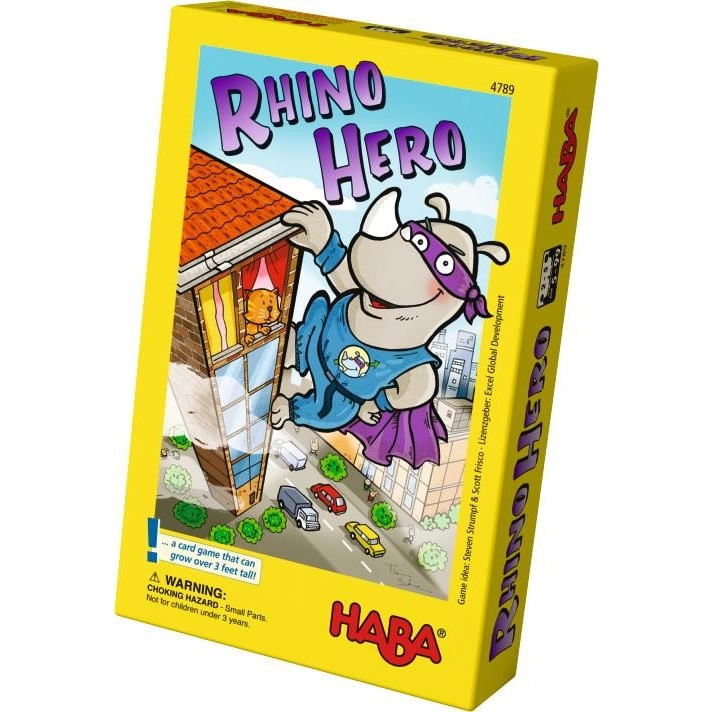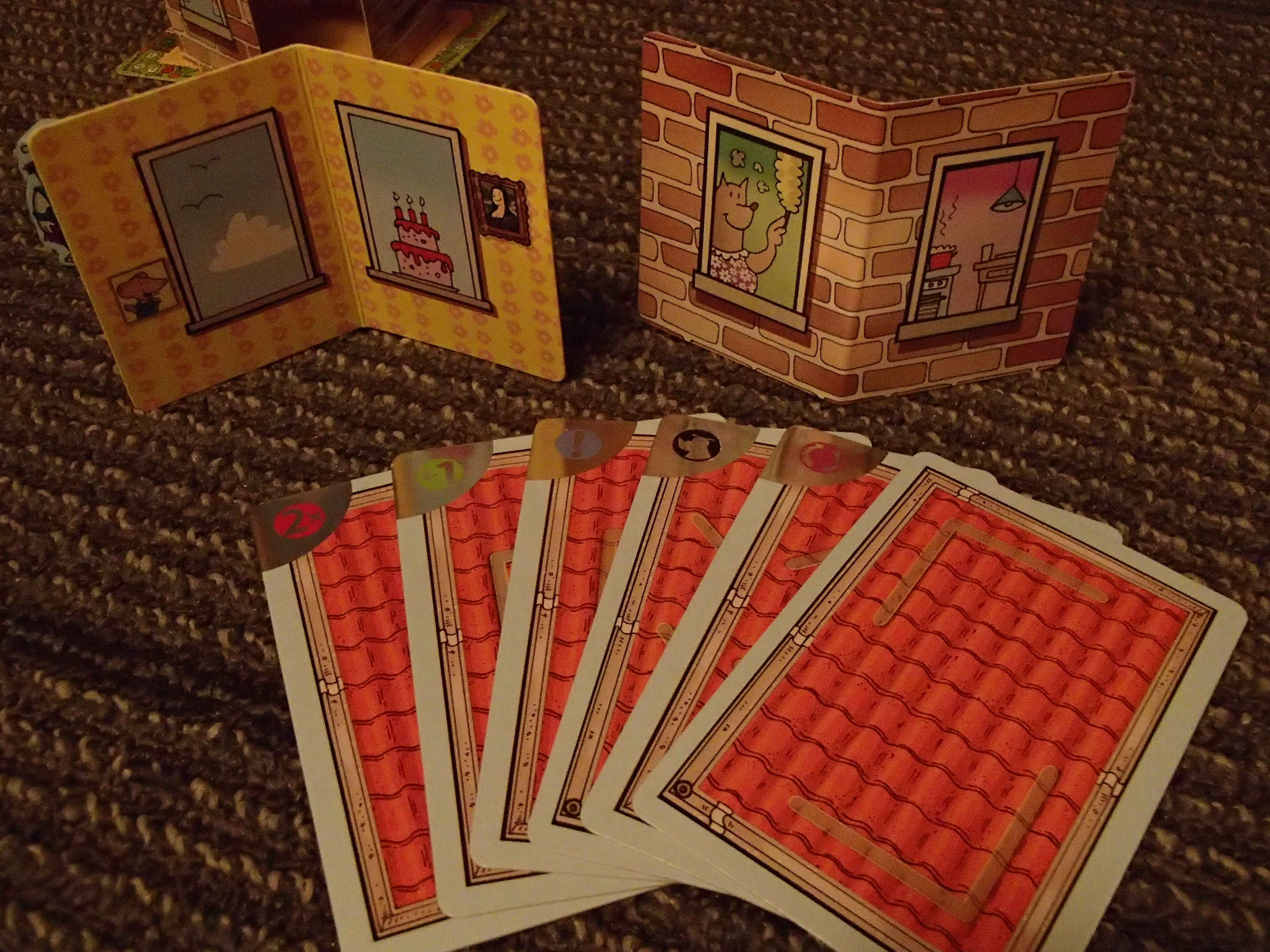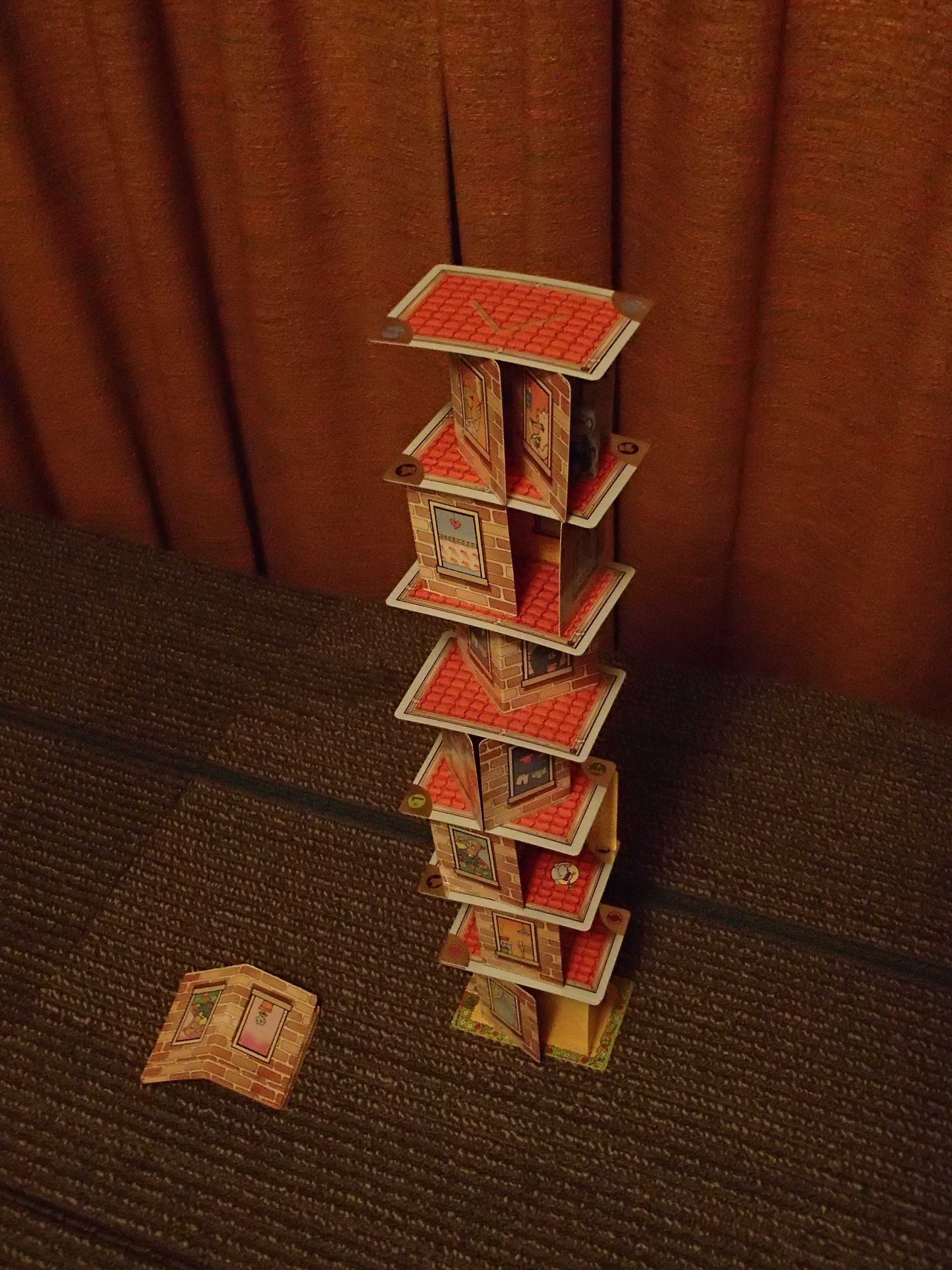| Publisher | Haba |
| Design Credits | Steven Strumpf, Scott Frisco |
| Art Credit | Thies Schwarz |
| Game Contents | 31 roof/action cards, 28 wall cards, foundation card, wooden Rhino Hero, rulebook |
| Guidelines | Superpowered pachyderm card-stacking game |
| MSRP | $12.99 |
| Reviewer | Andy Vetromile |
If you’ve ever played Uno, a favorite among family gatherings and small groups of friends, you’ve probably thought the same thing everyone else has thought at some point or another: What this game needs is a superhero rhinoceros. And so it came to pass someone decided this was a necessity whose time had come, and thus was born Rhino Hero.
Ever play Jenga? Same principle at work.
The object is to empty your hand of cards first.
Creators Steven Strumpf and Scott Frisco took both these designs in hand and fused them into a family dexterity game. Each player gets a hand of cards representing the rooftops of a multistory building. The foundation sits ready on the table next to a deck of walls (yes, a deck of walls) to get things off the ground. And what would Rhino Hero be without its eponymous protagonist? He’s a small wooden meeple with a picture on it of a rhino in a cape.
Rhino Hero needs to make the proverbial tall-building leap, though he’s going to do it from a tall building and not over it (rhinos make pretty hefty heroes), so he needs the players to give him something that’s going to make him look good. Walls in this game are folded cards, scored along their center so they sit upright and angled as the players build their . . . well, house of cards (really more of a multistory apartment building). The foundation tells the first citizen where to put his walls, which he then caps with one of his roof cards.
Some roofs are simple tops with printed outlines showing where the next set of walls goes. Having played one, your hand is now one card lighter and the next player has a go. Other cards don’t let your opponents off that easily, however. These may let a player put down two cards instead of one, skip an opponent’s turn, reverse the order of play, or force someone to draw another card (in addition to their construction duties). But the rhino cards . . .
Should the card display our hero, the afflicted player has to put up walls as normal but must also place the rhino meeple on that tier before capping it off with his rooftop. If Rhino Hero was already on a previous floor he must be gently extracted from there and moved to his new location. This continues with the stack getting taller and more unstable until either a player empties his hand of cards, skillfully winning the game, or some butterfingers knocks it down accidentally. In that case the clumsy participant loses and the others determine a winner based on who has the fewest cards left in hand.
To sum up the components: cards and a wooden animal. Rhino Hero is a delight – how could he not be? He’s a little meeple with a joyful horned superhero on it. The wall cards are repetitive in their design, but it’s all very kid-friendly and non-threatening and animal-related. The rooftop cards are shiny and pretty and solid, and the whole thing is compact and travels well. In HABA fashion, the rules are provided in English, French, Spanish, German, and what appears to be Korean.
Children will love the playful pachyderm and the colorful cards. The graphic distribution on the cards seems equitable, both of the various types of specialty cards on offer and the placement of walls for each roof. The lines dictating where the walls must go get in their own way sometimes, and since the rules state the walls have to follow those lines as closely as possible it’s frustrating when doing so demands a failing placement (especially for some of those that come with a Rhino Hero move – some cards just end up with the meeple and too much cardstock at one end). There aren’t wall cards sufficient to fill in all the spaces in the tower – the biggest tower could require 52 walls and there are only 28. This is only for the completist and the overachievers among gamers, of course; most of the time this won’t be a problem . . .
The mechanics are self-righting after a fashion: Neither the little gamers nor their wiser counterparts have a monopoly on steady hands, and everyone is vulnerable to a skipped turn. Finding a place to play depends on the family’s whims. Start on a kitchen table and the tower soon soars beyond the young ‘uns’ ability to reach the top; use the floor for your foundation and it’s only as stable as your carpet (and it requires the adults to hunker down to kid level). Regardless, the worse things go the funnier they are and the more entertaining the game becomes. Rhino Hero takes the best of two games and combines them into its own tricky, unsteady form of high (ahem) entertainment.



